Fine Coffee Learning Instant Coffee
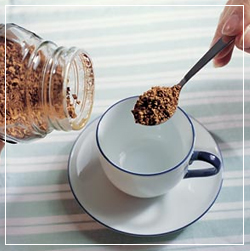
The decline and growth of coffee around the world has also led to a multi-dimensional development of coffee, and the deepest impact is the problem of instant coffee (Instant Coffee Powder Powder).
Instant coffee has the characteristics of easy to use, breaking the usual bundles of brewing coffee, and quickly integrated into the food industry. In China, instant coffee is of great use. In addition to being used for self-brewing, in the food processing industry, it can be made into coffee ingredients, three-in-one coffee powder and various kinds of coffee flavors. such as candy, milk, pudding, fruit, ice and baked goods, it is one of the important food raw materials in China.
Instant coffee has several generations of products, but the first stage of the processing process is the same, such as the selection, mixing, roasting, grinding and extraction of raw beans. The main difference lies in the different drying methods and external processing, in which each generation of products have their own usefulness, depending on the use. This paper describes the manufacturing process and product specification of instant coffee powder.
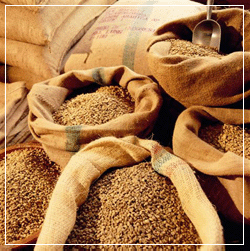
Raw or dry processed raw coffee beans, or Robusta and Arabica coffee beans can be used to produce instant coffee powder. Raw coffee beans are usually packed in sacks of 60 kg each, such as Robusta raw coffee beans from Brazil, Kenya and Africa; there are also packages of different weights, such as those from Costa Rica and Central / Latin America, which usually weigh 70 kg, as well as packages of 75, 80 and 90 kg.
The water content of raw coffee beans is less than 12%. At this level, the growth and enzyme activity of fungal bacteria are reduced to a minimum. Therefore, special attention should be paid to the control of temperature and environmental hygiene in Hong Kong, so as to avoid deterioration of raw beans and affecting the quantity of the most expensive products.
Due to the different added value of different grades of raw beans in the market, most instant coffee powders are not made from the highest grade raw beans, but mainly from ordinary raw beans. If this is the case, it is also necessary to choose raw beans with less disease, less scavenging, less broken beans, both in shape and size, otherwise you will not be able to produce products that are desirable to consumers.
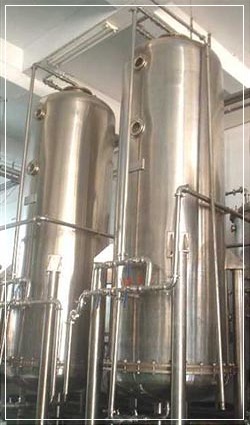
The main principle for choosing raw beans is based on the consideration of flavor volume and cost. Of course, there is also a single coffee product on the market, but most instant coffee is blended coffee. In the selection of coffee beans, it is difficult to understand the quantity of each variety and the characteristics of the source beans and the adaptability between them, in order to produce products that are suitable for fragrance and cost control, such as Robusta raw coffee beans from Indonesia, which can easily be imported from other sources.
In terms of cost control, the mixed raw beans of low-grade instant coffee will contain a large amount of Rrobusta raw beans or poor Brazilian beans. For those with sour taste and strong taste, Arabica raw beans processed in Chinese style and Brazilian raw beans with high grade are the main ones.
In addition to the consideration of fragrance and cost, the mixing of raw coffee and beans also has other advantages. The mixing of coffee beans can make the products meet the requirements of long-term stability, and the stability is reduced to a minimum. It is impossible to use a single source of raw coffee beans to meet the requirements of stability. In addition, the sudden shortage of symptoms caused by illness or illness can be avoided.
The selected raw beans can be roasted separately, then mixed, or mixed first, and then roasted together. The choice of these methods depends on such factors as the proximity of the amount of coffee beans and the size of raw beans, usually mixing first and then roasting.

Raw coffee beans must undergo a certain roasting process before they show the unique aroma and color of coffee, which is a very important step in the processing of coffee products. The main purpose of grinding is to promote the extraction of soluble solids and the dispersion of sporadic aromatic compounds.
Roasting is a combination of time and degree processing, which not only makes the formation of raw beans chemical, but also makes the structure of raw beans become physical. In the process of roasting, solids also contain a corresponding degree of loss, mainly in the form of volatile carbon dioxide, moisture and volatile matter loss.
Roasting is usually carried out under normal conditions, using burning materials and excess air as the medium, and can also be roasted by the contact on the surface of the metal. The degree of roasting can be judged by the appearance of coffee beans, the development of aroma, the loss of weight and the chemicalization of specific components. The degree of roasting is usually divided into three levels: mild, medium and heavy (Dark). The roasting degree can determine the characteristics of the extract.
The process of roasting can be divided into two stages. the first stage is the evaporation of water, which can remove about 12% of the moisture, and the time required for this stage is about 70% of the whole roasting time. At this time, the color of raw beans is changed from brown to hay, and then turned into light brown. The second stage is mainly for decomposition. At this time, raw beans will expand and blacken quickly, followed by the spread of oily oils and bursts. In this period, chemical composition changes very quickly, so it is necessary to quickly determine the timing of a cease-fire and cold weather. For example, Arabica coffee beans processed by rice can show the highest acidity after roasting, the taste is thin, and the taste is not fully displayed. When the roasting degree increases, the acidity decreases gradually, the taste becomes thicker and thicker, and the taste becomes stronger.
There are many types of coffee roasting machines, such as horizontal bucket roaster, vertical slot pan rotary machine, vertical rotary slot machine, mobile bed machine and force type machine. Horizontal bucket machine is the most common, which can be designed to operate in batches or links; vertical roasting machines are usually designed for batch operation; early mobile bed machines can only operate in batches, and recently they have been able to continue operation.
At the level of batch operation, the bean frying machine can roast about 240 kilograms of raw beans (four packs) per batch, and the roasting time is 10: 12 minutes. The addition is carried out in two stages, initially at a high loading rate, then at a low loading rate, until the release response (Exothermoic Reaction) occurs, and the air temperature in the baking tank can reach 450C. After the roasting is completed, the cold air blowing from the bottom to the top drops quickly, and the coffee beans are sent to the trough for use by the coffee conveyor.
Roasted coffee beans should be ground to facilitate extraction. There are many kinds of grinding machines, including cutting drum type, drum type and flat cylinder type and so on. In recent years, a grinder grinder has been exhibited. This kind of grinder can retain the most incense when it is grinded at low temperature. Generally speaking, the finer the grinder, the more convenient it is to extract, but it is also necessary to consider the convenience of processing. Usually the grinding is divided into two stages, the first stage is coarse crushed, and the second stage is ground to the desired grain size. During grinding, some water will also be added and mixed evenly to facilitate further processing.
Roasted coffee beans can maintain normal flavor and flavor for about a week under normal conditions, while the freshness of ground coffee beans can only be maintained for 2 to 3 days, so roasted coffee beans should be processed early to avoid deterioration.
Extraction is the most important processing operation of instant coffee powder, mainly extracting soluble substances and aromatherapy compounds from coffee. The extraction of coffee beans is an extremely complicated operation, and it is also very clear in science. In addition to the necessary equipment, it is also necessary to have rich experience.
Coffee extraction system can be divided into immersion sleeve type, reverse continuous spiral extraction system and stage extraction system. The immersion set of coarse extraction system is the most common. The ground coffee beans are placed in a fixed bed with the function of separating the liquid in the tank. The coffee beans are extracted in a countercurrent way with boiling water. Generally, there are 5 to 8 extraction tanks. The operation process takes the six-slot continuous extraction system as an example, the first tank is an empty tank (soybean dregs has been discharged), the raw material is prepared, the boiling water enters from the bottom of the second tank, and the ground coffee beans installed in the second tank have been extracted many times. as the raw coffee beans are renewed after this extraction, the extraction solution continues to extract the ground coffee beans in the third, fourth, fifth and sixth grooves, and the sixth tank is a new filling tank. In this way, we continue to refine the raw materials and remove bean dregs according to the trough sequence. In practice, the temperature of the water supply can be as high as 180 degrees Celsius. Due to the natural loss of the water supply and the absorption of coffee beans, the temperature of the water will be reduced to 100 degrees Celsius when it reaches the end of the tube column with new coffee beans. If the equipment has a good insulation effect, it can be reduced appropriately.
The extraction temperature of early coffee is 100 degrees Celsius. At this temperature, the extraction rate is very low, and it is easy to cause difficulties in drying. This kind of coffee powder has poor rheology and stickiness, so it is necessary to add some carbohydrates to increase the solid content. Extraction at degrees above 175 degrees Celsius can increase the extraction rate, especially the increase in carbohydrates, which can eliminate the above deficiencies and produce 100 percent instant coffee powder. Generally speaking, the solid content of the extract obtained from the extraction stage is less than 25%.
Do you want to be happy at work? OK, ┦ questions?] The components of incense and soluble solids were extracted and recovered separately, and some of them were extracted by mixed extraction. The latter was first extracted with water at 120 degrees Celsius, and most of the volatile perfume components and some soluble solids were extracted, and the extract was called Aroma. Secondly, the second stage extraction was carried out with 160C high temperature water. The product was Hydrolysate and a large number of soluble solids were extracted. If the product was mixed with different ratios, different grades of instant coffee powder could be prepared. Of course, the higher the Aroma ratio, the better the product quantity and the higher the quality. Generally speaking, the coffee powder used as the base material can use the products of Aroma 20% and Hydolysate 80%, while the coffee powder for fragrance needs to use 40% and more than 60% grade.
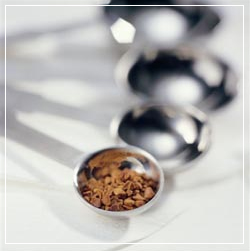
The quantity and specification of instant coffee powder include the control of incense, chemical composition, physical properties and microorganisms. It can be said that incense is the most important and most regulated project. It is necessary for rich functional quality and processing experts to carry out correct fragrance and control starting from the selection, mixing and roasting of beans in order to produce products of stable quality.
In terms of chemical composition, the main control projects are water content, caffeine content and PH value. The absorption of instant coffee powder is strong, so the water content must be strictly controlled, generally less than 3%. The content of caffeine has a significant effect on the taste of coffee, so its content should be determined, generally ranging from 2.5% to 5%. The PH value of instant coffee powder will not only affect the taste. It is particularly important for coffee powder for processing, because poor PH control in the processing process will lead to instability of other ingredients, such as milk powder or milk essence, which need to be specially regulated. in general, the PH value of instant coffee powder varies greatly, ranging from 3.5% to 5.5%.
In terms of physical properties, the main control projects include: color, volume density and grain size. Of course, it is impossible to be exactly the same, but it is also required that the data should be close, and the verification standard should be based on the color after adding water and bubble. it is not possible to use the naked eye as darker than the powder color. If there are too many bubbles in the ╊ grain, it will show a light color. The bulk density is related to the packing of sub-packaged and dry mixed processing products and needs to be specified. Grain size fractionation is related to its dispersion solubility, and the smaller the fractional range, the better.
In general, the microbial biomass of instant coffee powder products will mostly list the number of birth bacteria, macrophyte, yeast, fungus and so on. Basically, the lower the number of bacteria, the better, it is best not to exceed 30000 / g; the large bacteria in the health index should be sporadic; and the number of yeasts and bacteria should be less than 30000 / g.
Important Notice :
前街咖啡 FrontStreet Coffee has moved to new addredd:
FrontStreet Coffee Address: 315,Donghua East Road,GuangZhou
Tel:020 38364473
- Prev
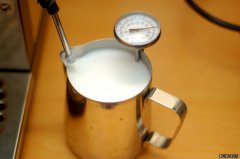
The knowledge of Italian Coffee drawing in detail the knowledge of Milk
The chemical composition of milk is protein, lipid, carbohydrate, inorganic, phospholipid, trace vitamins and so on. The formation of milk bubbles is due to the formation of a thin film on the surface when the milk is heated to more than 40 ℃. Just like we go to the convenience store to buy a bottle of fresh milk and heat it in the microwave, there will be a thin layer of fresh milk on the surface. That's milk protein.
- Next

Coffee drinking skills Coffee Taste Analysis
Flavor [flavor] is the overall impression of aroma, acidity, and mellowness, which can be used to describe the overall feeling of contrast coffee. Acidity [acidity] is the acidity and strong quality of all coffee grown on the plateau. The sour and sour mentioned here is different from bitterness or sour (sour), and it has nothing to do with pH, but promotes coffee to perform functions such as refreshing the mind and clearing the taste.
Related
- Beginners will see the "Coffee pull flower" guide!
- What is the difference between ice blog purified milk and ordinary milk coffee?
- Why is the Philippines the largest producer of crops in Liberia?
- For coffee extraction, should the fine powder be retained?
- How does extracted espresso fill pressed powder? How much strength does it take to press the powder?
- How to make jasmine cold extract coffee? Is the jasmine + latte good?
- Will this little toy really make the coffee taste better? How does Lily Drip affect coffee extraction?
- Will the action of slapping the filter cup also affect coffee extraction?
- What's the difference between powder-to-water ratio and powder-to-liquid ratio?
- What is the Ethiopian local species? What does it have to do with Heirloom native species?

